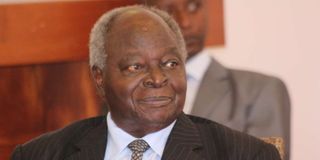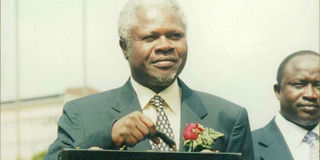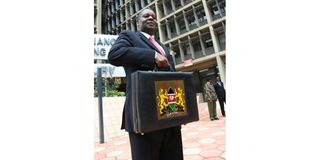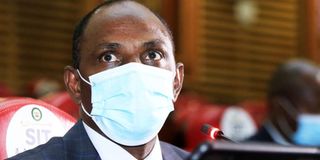
National Treasury
| File | Nation Media GroupNews
Premium
How Sh2 billion loans per day pushed Kenya into Sh7.2trn debt hole
April 9, 2013. President Uhuru Kenyatta is sworn in. As he assumes the most powerful office in the land, Kenya's total public debt is just Sh1.8 trillion.
If this debt was shared among the then population of 45.5 million Kenyans, each citizen would owe about Sh40,000.
After settling in State House, the seat of the presidency, President Kenyatta's youthful government changes tact, and starts an unprecedented spending on infrastructure, which required that he stepped hard on the debt gas pedal. The political promises had outweighed the cash in the coffers.
Sh7.2 trillion public debt
November 2020, 92 months later, Kenya's mountain of public debt has now climbed to Sh7.2 trillion. The Jubilee administration has been borrowing Sh59 billion every month, about Sh2 billion every 24 hours, thrusting East Africa's biggest economy into a dangerous cycle of debt.
Where that money has been sunk — in a country where corruption and kickback driven projects litter the terrain — is the question that dodges observers.
But the effects of the debt spree are becoming very difficult to hide.
Government is delaying to pay salaries. Counties are going for three months without disbursements — and the once-confident Treasury mandarins are mean with numbers.
Every citizen now owes Sh137,000, which is 3.4 times more than what they owed just eight years ago.
Domestic borrowing
Worse, for very Sh100 the taxman is collecting in taxes, the Treasury is spending Sh60 on debt repayments. Domestic borrowing has also been rising.
For instance, servicing costs for six months between July and December 2020 stood at Sh413.51 billion against tax receipts of Sh673.61 billion.
A cash strapped government is increasing taxes in the middle of a pandemic. The economy that is dangerously addicted to debt has been hit by the Covid-19 pandemic, and has just slipped into a recession for the first time in two decades.
Lacking the stomach to tackle spiralling debt, Treasury is extending its requests for a debt repayment holiday to all bilateral lenders, desperately looking for some breathing space to reduce its debt interest burden.
First, it was global ratings agency Moody's that flashed the first red signal in 2008, after it downgraded Kenya's credit scores to B2 from B1, citing pressure from the country's rising debts.
"The drivers of the downgrade relate to an erosion of fiscal metrics and rising liquidity risks that point to overall credit metrics consistent with a B2 rating," Moody's said in its downgrade note to investors.
‘High credit risk’
"The fiscal outlook is weakening with a rise in debt levels and deterioration in debt affordability that Moody's expects to continue."
While a B2 is considered a “high credit risk”, Treasury did not like the new status and quickly disputed the downgrade, arguing that it did not reflect the country's fundamentals.
Then came International Monetary Fund (IMF) and the World Bank, which in various reports raised concerns after Kenya's GDP to debt ratio crossed the 50 per cent mark and started racing towards 60 per cent. The recommended threshold for developing countries is 40 per cent.
And that was not all.
Parliament’s budget office also joined the chorus, advising repeatedly in its quarterly reports that Kenya needed to ease its foot on the debt gas pedal, and focus on completing old projects before starting new ones.
Other reputable institutions and independent economists, such as the Institute of Certified Public Accountants of Kenya (ICPAK) and the Institute of Economic Affairs (IEA), have also added their voice on the debt crisis facing the country.
But it is the downgrade of Kenya's credit ratings outlook by Moody's and Standard and Poor's (S&P) and the raising of Kenya's risk of debt distress to high by the IMF that jerked Treasury mandarins into action.
In changing Kenya's risk of debt distress to high from moderate, the IMF said Kenya's debt stood at 61.7 per cent of GDP at the end of 2019, up from 50.2 per cent at the end of 2015, driven up by budget deficits caused by large infrastructure projects, such as a new railway line.
Major risk for economy
By this time, it was now indisputable that debt has now become a major risk for the economy, and the Treasury was now recognising it in its budget policy statements.
Being among 76 low-income countries benefiting from a global Debt Service Suspension Initiative (DSSI) by the G20 grouping of the world's largest economies is not enough to soften its debt crisis triggered by the rising cost of servicing public debt.
A restless taxman is ruthlessly pursuing taxpayers struggling to keep their businesses afloat. A broke Treasury, unable to follow through with austerity measures, is running out of options.
But the biggest nightmare is a growing debt crisis, whose all danger signals are blinking red.
Just how did Kenya get here? Where did the Sh5.4 trillion borrowed by the Jubilee administration go? And how has President Kenyatta's finance bosses fared compared with their predecessors.
As Kenyans jeered and smeared mud on President Daniel arap Moi in December 2002, tired of a president who had ruled the country with an iron fist, and left the country's economy in tumbles, the stock of Kenya's total public debt was just Sh630 billion. This is according to official data from the Central Bank of Kenya (CBK).

Former President Mwai Kibaki who weaned the economy from the over dependence on foreign lenders, leaving behind a country that could comfortably fund its own budget.
Mwai Kibaki
Then Mwai Kibaki, an economist, and a former finance minister came in December 2002 during the big opposition wave that swept him into office.
Kibaki increased Kenya's public debt to Sh1.8 trillion. This translated to about Sh14.5 billion every month or Sh480 million every day. But he presided over a government that lived within its means, only borrowed when it was necessary, but most importantly, weaned the economy from the over dependence on foreign lenders, leaving behind a country that could comfortably fund its own budget.
Jubilee government
That was before the Jubilee government came in and threw all caution to the wind, borrowing Sh5.4 trillion in 92 months.
To put this number in perspective, if this amount was to be used to build the standard gauge railway (SGR), then Kenya would have put up 17 such railways like the one between Nairobi and Mombasa around the country. If it was just to build super highways with the money, then it will put up 154 Thika superhighways.
Though debt is driven by the spending priorities of the government of the day, it is the finance ministers, who prepare the budgets, advice the governments on how best to fund them. They are also the men and women who sign off on the various debt instruments and loans borrowed.
Best and worst finance ministers
To put in perspective how avaricious the current administration is in terms of debt accumulation, we have gone back to September 1999, when Chris Okemo took over the Ministry of Finance, to track how Kenya got where it is today.
Okemo served for about 21 months. During his time, he found the total debt book at Sh503 billion. In his time, Okemo borrowed about Sh100.9 billion. This works out to Sh5 billion every month or Sh160 million every day.

Former Finance minister Chris Okemo. In his time, Okemo borrowed about Sh100.9 billion. This works out to Sh5 billion every month or Sh160 million every day.
His successor, Christopher Obure was at the Treasury for about one year from December 2001. In 12 months, Obure borrowed Sh23.2 billion. This is about Sh1.9 billion every month or Sh65 million per day.
Obure, the last of President Moi's finance ministers slowed down the pace at which the government was borrowing substantially, and when he left, the country's public debt stood at about Sh630 billion.
Kibaki era
Then entered President Mwai Kibaki, who trusted public coffers with David Mwiraria. During his time Mwiraria borrowed at a much faster pace in his 38 months at the National Treasury than his predecessor, but it was still within sustainability thresholds. During his time as the Finance minister, Mwiraria increased Kenya's debt by Sh112.7 billion, which is about Sh3 billion per month or Sh100 million every 24 hours.
By the time Mwiraria resigned in February 2006 after being linked to the Anglo Leasing Scandal, Kenya's public debt had grown to 745 billion.

Former Finance minister David Mwiraria who, during his time, borrowed at a much faster pace in his 38 months at the National Treasury than his predecessor, but it was still within sustainability thresholds.
After Mwiraria came Amos Kimunya. The man who became famous for his phrase “I would rather die than resign” had about two turbulent years at the Treasury buildings where he increased Kenya's debt by about Sh117 billion. Kimunya was borrowing about Sh4 billion every month or Sh140 million every day. The Grand Regency hotel saga would eat him up on July 8 2008, when he was forced to hurriedly resign from office. At that time, the public debt was about Sh860 billion.

Mr Amos Kimunya. As Finance minister, Kimunya was borrowing about Sh4 billion every month or Sh140 million every day.
The late John Michuki would take over the Treasury docket in an acting capacity. In this transition period of about six months, the Treasury was borrowing about Sh18.6 billion every month or Sh621 million per day. In his few months in office, Kenya had borrowed Sh111 billion. This saw him exit when Kenya's debt was at Sh972 billion.
Uhuru’s turn
January 2009. It was now Uhuru Kenyatta’s turn at the National Treasury. Uhuru, who would later be elected the fourth president of Kenya, increased the pace at which the government was borrowing in his 37 months in office. As if to point at the times to come, in his 37 months in office, before he was hounded out by the ghosts of the International Criminal Court, Uhuru had increased Kenya's debt by Sh529.2 billion. This works out to Sh14.3 billion per month or Sh477 million every 24 hours.
His successor Robinson Njeru Githae did not slow down this momentum set by President Kenyatta. He stepped much harder on the accelerator pedal and was borrowing Sh764 million every day, which saw Kenya increase its debt by Sh23 billion every month.
‘Eat rats’
By the end of his 16-month stint at Treasury, the man who suggested that Kenyans could eat rats to beat cyclic starvation had increased Kenya's public debt by another Sh 367 billion.
Githae would then hand over to Henry Rotich as the Jubilee administration took charge. Rotich quickly took queue on his government's appetite for debt to preside over Kenya's most aggressive debt accumulation. Rotich came with Eurobonds, speeded up government-to-government debt funded projects, and aggressively competed with private sector for domestic debt, to land Kenya into the red zone.
Rotich, who is also the longest serving finance boss in Kenya in the past two decades, borrowed a staggering Sh4.1 trillion in 74 months. This is when all of Kenya's debt signals started blinking red. He was borrowing an average of Sh1.8 billion every day, or Sh56 billion every month.
Puzzle
Where all this money went, which roads it built, is still a puzzle given that the biggest infrastructure project within that period was the SGR, and its cost was Sh327 billion. Rotich was hounded out of office due to the Arror and Kimwarer dams scandals — awarded to Italian firm, CMC de Ravenna.
Rotich left office before the Treasury could provide a list of all the projects the Eurobond billions funded.
Most frightening nightmare
If Rotich's era was a nightmare, then Ukur Yatani's era is going to be the most frightening nightmare of all time. In Just 15 months to November 2020, Yatani had increased Kenya's debt by Sh1.2 trillion. This works out as Sh77 billion per month or Sh2.6 billion per day.
At this pace, by November 2021, Yatani would have borrowed another Sh950 billion, which will bring Kenya's debt to Sh8.2 trillion. This will leave him with just about Sh800 billion to breach the Sh9 trillion debt ceiling.
This means that the first order of business for the next president will be to increase the debt ceiling in 2022 or his or her government will go burst.
In the latest Budget Policy Statement (BPS) for the 2021/22 financial year, Yatani lists debt sustainability as one of the four major risks facing the country’s economy.

National Treasury CS Ukur Yatani. His era is going to be the most frightening nightmare of all time.
The other risks are defaults by parastatals on debts guaranteed by the government as well as fiscal risks related to devolution.
"Under performance of the economy worsens the debt indicators, thus unsustainability. However, with fiscal consolidation, the government aims to contain the pace of borrowing and hence reduce the debt ratios," Yatani says in the BPS document.
The BPS is a government policy document that sets out the broad strategic priorities and policy goals to guide the national government and the county governments in preparing their budgets for the subsequent financial year and over the medium term.
Restructure maturing loans
The document adds that contracting of new debt on short term maturities increases the refinancing risk but the government strategy is to restructure the maturing loans for external and domestic with loans of longer-term maturities.
"The government will continue with active liability management operations in the domestic debt primary market by switching short term domestic debt to longer term domestic debt, with the aim of lengthening the maturity structure," the document says.
"To cushion the country against the downsides of the risks emanating from the global sphere, the government is deepening reforms in the domestic debt market to ensure a stable and strong financial system in Kenya capable of funding increasing share of the fiscal deficits."
The document adds that Kenya faces a fiscal risk as the Kenya shilling continues to depreciate due to the fact that 51 per cent of the debt is held in external currencies.
"This has led to increase in debt service budget in local currency and also increase on the stock of debt without inflows. The ongoing global Covid-19 shock has worsened the debt indicators. However, this is expected to be temporary as global economy recovers from the crisis."
Treasury notes that prudent macroeconomic management (including monetary policy and fiscal consolidation) will help keep the exchange rate stable.





